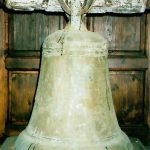In the 12th century, the Castle of La Penna already existed (the toponym derives from pinnule, the gentle hills on which it stands), strategically positioned to defend the course of the Arno River. It belonged to the Ubertini family, the well-known rural counts of Arezzo, who were also lords of Laterina.This small castle, with its keep, was later rebuilt during the 13th and 14th centuries. It had an irregular quadrangular shape, with two gates in the crenellated walls (one to the west and the other to the east). Today, a large and imposing section of these walls still exists, particularly around the northern corner, which overlooks the fields on the side opposite the river. The remains of the crenellations, partly hidden by dense undergrowth and climbing vegetation, offer some striking and romantic views.The jambs of the eastern gate also remain, from which a road branched out, crossing a small ravine via a single-arched stone bridge (still extant), and passing by the present-day locality of La Rocca. The church of San Lorenzo is first mentioned in 1128 within the castle of La Penna. We also know that in 1196, Monsoglio had a hospital for the sick and pilgrims, also under the patronage of the Ubertini family, and subject to the famous Abbey of San Trinita of Fonte Benedetta (or in Alpi, near Talla), a powerful Benedictine monastery within the orbit of the Ubertini themselves.
In 1289, after the epic Florentine victory in the plain of Campaldino, the Ubertini were forced to cede the Castello della Penna to Florence.In the second quarter of the 14th century, several small local tyrannies came to the forefront, including that of Francesco “della Penna,” a member of a branch of the Tarlati family. After Florence’s definitive victory over Arezzo in 1385, some Florentine officials conducted an inspection of the Castello della Penna, still virtually owned by Angelo Tarlati, describing it as “a strong castle with a very strong palace.”
In 1386, Angelo di Francesco Tarlati, having lost all power, finally placed the castle under the accomandigia (i.e., the protection) of Florence. The castle, downgraded to a villa (a rural settlement), would pass to Uguccione Tarlati, but would ultimately fall under the direct control of Florence.In the Florentine tax register of 1427, Ranieri di Niccolò Peruzzi (from one of the wealthiest and most powerful Guelf families of merchants and bankers in Florence) is already recorded as holding some “perpetual rents from La Penna.” Evidently, the policy of the Florentine Republic was to ‘infiltrate’ the recently conquered territories with families loyal to the Guelf faction and of ‘popular’ allegiance.
In 1480, the Peruzzi family also held the patronage of the Church of San Lorenzo, for which they had a new bell cast in Florence, still preserved at the villa of Monsoglio. After Antonio was declared a rebel in 1534, his lands in Penna and Rondine were sold by the Ufficiali de’ Ribelli to Captain Antonio de’ Mozzi, but in 1566 they were returned to the Peruzzi family. Following their acquisition by the Capponi family, the buildings of Penna were owned by the Pasquali Da Cepperello family starting in 1884.Between 1928 and 1929, Augusto Pasquali had the Church of San Lorenzo restored, with the interior decorated in a neo-Gothic style on the walls and the rafters. In the oculus window on the facade, the double coat of arms of the Pasquali and Da Cepperello families was depicted. The painting The Crucifixion was also likely placed on the main altar at that time.







